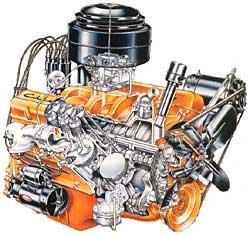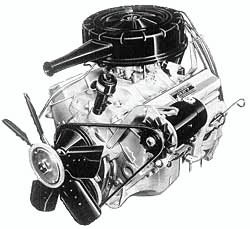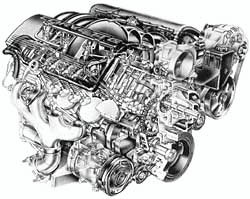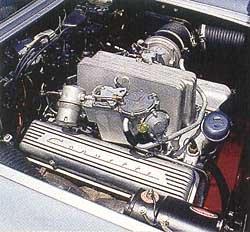The History of CHEVROLET
 |
Chevy Engines Through Time This story was taken from Super Chevy magazine, October 2000 Written by Shane Reichardt |
|
When Chevrolet began building vehicles, they were powered by a 299ci, six-cylinder engine. These automobiles could reach a top speed of 65 mph "without taxing themselves," and accelerated from zero to 50 in an "astounding" 15 seconds. By today's standards this isn't too impressive, but at the time Chevrolet was one of the fastest vehicles on the road.
In the early years, there was a great deal of research and development dedicated to coming up with a powerful engine that could be produced for a reasonable price. Chevy's first V-8 engine was released in 1917. The 90-degree overhead-valve design debuted in the D-series, the last of the original longwheelbase cars. The eight-cylinder lasted only two years, as Chevrolet dropped these "large" powerplants to develop four-cylinder versions. It would be 1929 before a sixcylinder reappeared, and a V-8 wouldn't be available again until the introduction of the legendary small-block in 1955, 36 years later New engine technology- including "copper-cooled" models-was explored during Chevy's first decade. These were superior vehicles with air-cooled engines instead of the traditional liquid-cooled models. The engine was the smallest in Chevrolet history; a diminutive 135 cubic inches with a miniscule 20 horsepower The experiment was brief-, the engine was plagued with production problems and was scrapped after only 759 units were built-yet it was a bold move by a growing automaker willing to take chances in an oft-skeptical market. Another attempt at air-cooling would take place 37 years later with the '60 Corvair. By 1925, Chevrolet was considering the use of six-cylinders again. Having just designed a small six for the Oakland division, Chevrolet realized it would have to maintain the corporate advertising image, "Valve-in-Head, Ahead in Value." The valve-in-head "Stovebolt Six" resulted: 3.2 liters big and 46 horsepower strong. At first, the industry looked upon this six with doubt. Manufacturers were heading toward using aluminum to save weight, but Chevrolet made the decision to persevere with iron. The engine was derided as the "Cast-Iron Wonder," and the "Stovebolt Six" moniker was originally meant to mock the engine. But it gained respect for its durability and easy-to-service features in both cars and trucks. Advertised as, "A Six for the Price of a Four" in 1929 models, the "Stovebolt Six" was better, more powerful, and in the same price range as the previous year's four-cylinder. A "power war"was developing between the major auto companies during the mid '30s: Ford's V-8 versus the six-cylinder engines from Chevrolet and Chrysler To baffle Ford's horsepower and top speed claims, Chevrolet introduced a new highcompression design, the "Blue Flame" Six, in 1934. It generated 15 more horsepower than previous sixes without increasing engine displacement. Chevrolet promoted the achievement by advertising "80 horsepower at 80 miles per hour," the only time in Chevy history that top speed was advertised. Ford was pumping the market with V-8 engines during this time, and Chevy developed a new four-main-bearing six for its 1937 cars and trucks. The Chevy engine produced as much horsepower as the Ford, but with better economy (estimated 15 to 18 mpg). In 1950, Chevy introduced a more powerful "Blue Flame" Six (with 235 cubic inches), and 300,000 Chevrolet cars equipped with "Powerglide" models were sold the first year .. a record production year in which a whopping 2,108,273 Chevrolets were built! As most Chevy enthusiasts know, the '55 Chevy made a huge impact on the automotive market when it showed up, and much of that impact came from the all-new 265-inch V-8 engine under the hood. An engineering milestone, the small-block almost instantly changed the poky image that Chevrolet had earned with its Stovebolt six. The new V-8 was peppy, smooth, tough, compact, and, unlike competitors' V-8 powerplants, it was light. The mouse motor, as it became known as, made big strides in its first few years, jumping from a 180 hp top offering in '55 to 211 available ponies the next year. Optional fuel injection in '57 helped a bigger, 283-inch smallblock hit the magical, one horsepower-per-cubic-inch mark. This made screamers out of both fullsize Chevys and Corvettes, and it certainly caught the attention of hot rodders, who soon started swapping smallblocks into just about every kind of car imaginable. Chevrolet offered an all-new engine for 1958 -- the W-block 348 (which would eventually grow into the famed 409). Paired with the year-old Turboglide transmission, the 348 looked good on paper; especially the 315hp version equipped with three twobarrel carbs. But most 348s could still be regularly outrun by the lighter, high-winding 283s. It would take a few more cubic inches before these early "big-blocks" would earn more performance respect. The '59s were most notable under the hood, where an optional V-8 engine produced up to 315 bhp. This "burner" thrived during the "more power" competition between the manufacturers. The SS Impala and its optional 409-cid V-8 quickly proved itself on the performance circuit. One of the first cars equipped with this new powerhouse blew away the competition at the 1961 Winternationals Drag Racing Championships, held in Pomona, California. In fact, the 409, coupled with a four-speed transmission and some handling extras, placed the Impala SS among the world's fastest automobiles at the time. For 1962, the SS package could be combined with an even gutsier, dual-quad, 409-horse 409. An innovative departure from the crowd was introduced on the Corvair. An air-cooled, rear-mounted six-cylinder "pancake" engine powered the car (the first air-cooled Chevy since the mostly experimental 1923 coppercooled model). Another compact car was the Monza Spyder; a 150 horse, turbocharged "mover" that could outrun any Ford Falcon or Plymouth Valiant of the day. Throughout the '60s the inline six remained popular, but it was the small-block V-8s that really came into their own. Fuel-injected 327s making up to 360 hp were highlights of the next generation of Corvettes, the Sting Rays. Carbureted 327s found their way into the '65-67 Nova SSs. The '66 Nova SS, when equipped with the available 350hp (L79) version of the 327 "Turbo-Fire" V-8, was one of the hottest performers in the compact class. In 1967, the most popular configuration of the small-block V-8, the 350, made its debut. It found a welcome home in the newly introduced Camaro.  Of course, a new generation of big-block V-8s made a big impact in the '60s as well. The 396 made its debut in 1965, and was a standout performer in Corvette trim, pumping out 425 hp. A 375-horse version made it into a select few '65 Chevelles (Z-16s), and by '66 the SS396 package was a big seller in the Chevelle line. A larger, 427-inch big-block added more heat to the 'Vette that year, paving the way for the legendary L88 the following few years. The big-block eventually grew to 454 cubic inches, and by 1970 cranked out 450 hp in LS6 trim. For 1971, ratings would be displayed as "net" horsepower, rather than the brawny "bhp," or brake horsepower ratings that had been performance benchmarks. The plummeting numbers began to reflect the awakening of energy conservation; an awareness that would increase dramatically in this new decade. In addition, the 1973 oil embargo caused gas prices to double within two years. Suddenly, fuel economy was important ... very important. Fuel concerns led to smaller, more efficient cars. Though the big-motored behemoths were gone from the dealerships, performance was still on the minds of more than just a few buyers. The second generation Chevrolet subcompact -- Monza -- evolved in 1975 as a sporty offshoot of the Vega platform, A front-engine, rear-drive hatchback, Monza provided smaller engines for the energy-conscious, yet offered optional V-8 power for those still wanting punch under the hood. In fact, its 262-cid V-8 was the smallest eight-cylinder in Chevrolet history. The Chevy Sprint, a unique three cylinder minicar, was introduced on the West Coast in 1984, and was the smallest car to ever wear a Bow-Tie. Imported from Suzuki Motor in Japan, Sprint economy was so outstanding that it became the fuelmiser champ in 1986 when the "ER" arrived - EPA-rated at of 55 mpg city and 60 mpg highway. (There was even a sporty limited production turbo version, a founding member of the now-burgeoning sport compact car craze.)  Chevrolet introduced the special Corvette ZR-1 in 1990. Designed in a cooperative effort between General Motors and Lotus, the LT5 V-8 engine sported four cams and 32 valves, producing 375 horsepower. 1993 marked a number of upgrades and improvements. The outstanding Corvette ZR-1 received a refined LT5 engine, cranking out an unbelievable 405 horsepower. Trucks weren't ignored throughout Chevy's history, either. On a much less obvious basis, many half- and three-quarter ton pickups over the years were ordered with a stout big-block beneath the hood. One hauler was even promoted as a performance version, and was called the 454 SS. Under the hood of the 454 "SS" was a 454-cid Mark V big-block V-8, hence the name (despite the fact that the power levels didn't live up to its moniker, it still made the competition nervous, and it could definitely haul things to the dump).  THE EVER-POPULAR SMALL-BLOCK When you think of the best engines of all time there's one that definitely stands out-the 1955 Chevy small-block. While that engine has unquestionably set the standard by which all engines since have been judged, it's not the only milestone in Chevrolet's history. Many of the various powerplants that have provided motivation for Chevy's cars and trucks throughout time were innovative works of art in their own right, but none ever came close to having the same effect on our hobby as the little mouse motor has. Fortunately, Chevy hasn't rested on its laurels. Today an array of impressive powerplants are available (though most of the really exciting ones-sans the LS1 can only be had through the GM Performance Parts division and not on the cars found on the dealer's showroom floor). Today's vehicles are primarily designed to simply get people from one place to the next without much emphasis placed on performance. Corvette and Camaro are the only holdouts from the high-performance arena. Both of Chevy's sports cars currently offer the impressive LS1 engine and a performance package at a price that's nothing short of phenomenal. Sadly, sales of these two vehicles (the F-body's are dismal and the Vette only accounts for a small percentage of Chevy's overall revenue) has left them without many supporters in GM's corporate structure. Furthermore, the Camaro is said to go on hiatus following the 2002 model year for an undisclosed period and there are no guarantees on what type of ride, if any at all, will emerge from the other end of that dark tunnel. ONE HORSEPOWER PER SQUARE INCH For a long time, one horsepower per cubic inch (of displacement) was the unobtainable goal. A milestone to be pondered: "Wouldn't it be cool to get a horse per inch?" Today, reaching that level is a fairly simple task (although few production cars make it there). With simple bolt-ons from the performance aftermarket, enthusiasts can achieve well in excess of one horse per cubic inch. Super Chevy magazine has built engines that churn out horsepower three times the displacement numbers. Chevrolet first hit the one-horsepowerper-cubic-inch level in 1957. The 283 smallblock was fitted with Rochester mechanical fuel injection (called "Ramjet injection") and churned out an impressive 283 ponies (a number that grew to 290 the following year). Unfortunately, though, Chrysler beat Chevy to the punch by making a whopping 355 horsepower with its 354 cubic-inch Hemi a year before.  Many of the higher-horsepower engines were actually power packages added to the base engine. Engineers knew that the standard -equipment engines benefited greatly from a little better breathing. The answer was to offer special packages that featured bigger carburetors (or multiple carbs, or fuel injection). The dual-quad carburetor setup (also immortalized in the Beach Boys song "409") was part of a power package designed to beat the competition in the horsepower game. At one time there were 158 different versions of the small-block being produced by Chevrolet -that's a lot of different ways to get power. | |
Site & graphics © 2014 Pixel Twister Web Design.
The following urls point to this site:
www.55-57chevys.com - www.coccc.com - www.classicchevyclub.com -www.classicchevy.info - www.okclassics.com - www.oklahomachevys.com - www.okchevys.com - www.autolinks.org